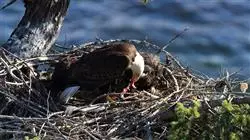University certificate
The world's largest faculty of veterinary medicine”
Introduction to the Program
Do not miss the opportunity to take this Professional master’s degree in Wildlife Management with us. It's the perfect opportunity to advance your career”

The Professional master’s degree in Wildlife Management is a broadly specialized program with an inherent coherence to its structure, which allows specialization in the main disciplines related to wildlife conservation.
It addresses all the fundamental concepts that form the necessary ecological basis on which to build throughout the syllabus. In addition, it defines the fundamental international regulatory framework for biodiversity conservation.
It analyzes one of the main threats to biodiversity loss i.e., invasive alien species, establishing the main lines of action to manage them.
It examines how to monitor wildlife through direct or indirect observations, such as droppings, nests, pellets and other natural signs of wildlife, analyzing the main census methods used for fundamental species when developing wildlife monitoring programs.
It also addresses hunting management as one more piece of the puzzle in the treatment of wildlife and conservation, so the objective to be achieved will be to carry out a sustainable use of resources, setting rhythms that do not lead to the decrease of biological diversity in the long term while integrating other uses into the environment.
At the same time, it presents all the relevant aspects to estimate livestock burdens placed on the environment and to determine quotas to establish sustainable hunting management. It will also determine the main factors to analyze and incorporate when making a correct Technical Hunting Plan.
It analyzes the regulatory framework of wildlife diseases in detail, as well as action protocols in case of signs or suspicion of the main diseases associated with wildlife.
This Professional master’s degree provides specialized knowledge to perform an in-depth statistical analysis. All this is defined from a theoretical point of view in the first place, to be subsequently developed through Statistica software.
The program covers Distance software, the most widely used computer program to analyze wildlife sampling data, developing the necessary sections for data import, analysis configuration and validation of results.
Moreover, the territorial management of species is not an issue linked to field interpretation and management. Species distribution data are increasingly analyzed from a technological perspective in the office. The inclusion of teaching units based on technologies, such as geographic information systems, is useful to represent field data graphically and interpretatively through maps.
Specialize with us and learn the concepts associated with wildlife populations and the processes and interactions that take place”
This Professional master’s degree in Wildlife Management contains the most complete and up-to-date scientific program on the market. The most important features include:
- Case studies presented by experts in Wildlife
- The graphic, schematic, and practical contents with which they are created, provide scientific and practical information on the disciplines that are essential for professional development
- New developments in Wildlife Management
- Practical exercises where the self-assessment process can be carried out to improve learning
- Special emphasis on innovative methodologies in Wildlife Management
- Theoretical lessons, questions for experts, discussion forums on controversial issues and individual reflection work
- Content that is accessible from any fixed or portable device with an Internet connection
This Professional master’s degree is the best investment you can make in the selection of an updated program in Wildlife Management”
Its teaching staff includes professionals belonging to the veterinary field, who contribute their expertise to this specialization, as well as renowned specialists from leading societies and prestigious universities.
The multimedia content, developed with the latest educational technology, will provide the professional with situated and contextual learning, i.e., a simulated environment that will provide immersive specialization programmed to learn in real situations.
This program is designed around Problem-Based Learning, whereby the specialist must try to solve the different professional practice situations that arise throughout the program. For this purpose, the professional will be assisted by an innovative, interactive video system created by renowned and experienced experts in Wildlife Management
This program comes with the best educational material, providing you with a contextual approach that will facilitate your learning"

This 100% online Professional master’s degree will allow you to combine your studies with your professional work while increasing your knowledge in this field"
Why study at TECH?
TECH is the world’s largest online university. With an impressive catalog of more than 14,000 university programs available in 11 languages, it is positioned as a leader in employability, with a 99% job placement rate. In addition, it relies on an enormous faculty of more than 6,000 professors of the highest international renown.

Study at the world's largest online university and guarantee your professional success. The future starts at TECH”
The world’s best online university according to FORBES
The prestigious Forbes magazine, specialized in business and finance, has highlighted TECH as “the world's best online university” This is what they have recently stated in an article in their digital edition in which they echo the success story of this institution, “thanks to the academic offer it provides, the selection of its teaching staff, and an innovative learning method aimed at educating the professionals of the future”
A revolutionary study method, a cutting-edge faculty and a practical focus: the key to TECH's success.
The most complete study plans on the university scene
TECH offers the most complete study plans on the university scene, with syllabuses that cover fundamental concepts and, at the same time, the main scientific advances in their specific scientific areas. In addition, these programs are continuously being updated to guarantee students the academic vanguard and the most in-demand professional skills. In this way, the university's qualifications provide its graduates with a significant advantage to propel their careers to success.
TECH offers the most comprehensive and intensive study plans on the current university scene.
A world-class teaching staff
TECH's teaching staff is made up of more than 6,000 professors with the highest international recognition. Professors, researchers and top executives of multinational companies, including Isaiah Covington, performance coach of the Boston Celtics; Magda Romanska, principal investigator at Harvard MetaLAB; Ignacio Wistumba, chairman of the department of translational molecular pathology at MD Anderson Cancer Center; and D.W. Pine, creative director of TIME magazine, among others.
Internationally renowned experts, specialized in different branches of Health, Technology, Communication and Business, form part of the TECH faculty.
A unique learning method
TECH is the first university to use Relearning in all its programs. It is the best online learning methodology, accredited with international teaching quality certifications, provided by prestigious educational agencies. In addition, this disruptive educational model is complemented with the “Case Method”, thereby setting up a unique online teaching strategy. Innovative teaching resources are also implemented, including detailed videos, infographics and interactive summaries.
TECH combines Relearning and the Case Method in all its university programs to guarantee excellent theoretical and practical learning, studying whenever and wherever you want.
The world's largest online university
TECH is the world’s largest online university. We are the largest educational institution, with the best and widest online educational catalog, one hundred percent online and covering the vast majority of areas of knowledge. We offer a large selection of our own degrees and accredited online undergraduate and postgraduate degrees. In total, more than 14,000 university degrees, in eleven different languages, make us the largest educational largest in the world.
TECH has the world's most extensive catalog of academic and official programs, available in more than 11 languages.
Google Premier Partner
The American technology giant has awarded TECH the Google Google Premier Partner badge. This award, which is only available to 3% of the world's companies, highlights the efficient, flexible and tailored experience that this university provides to students. The recognition as a Google Premier Partner not only accredits the maximum rigor, performance and investment in TECH's digital infrastructures, but also places this university as one of the world's leading technology companies.
Google has positioned TECH in the top 3% of the world's most important technology companies by awarding it its Google Premier Partner badge.
The official online university of the NBA
TECH is the official online university of the NBA. Thanks to our agreement with the biggest league in basketball, we offer our students exclusive university programs, as well as a wide variety of educational resources focused on the business of the league and other areas of the sports industry. Each program is made up of a uniquely designed syllabus and features exceptional guest hosts: professionals with a distinguished sports background who will offer their expertise on the most relevant topics.
TECH has been selected by the NBA, the world's top basketball league, as its official online university.
The top-rated university by its students
Students have positioned TECH as the world's top-rated university on the main review websites, with a highest rating of 4.9 out of 5, obtained from more than 1,000 reviews. These results consolidate TECH as the benchmark university institution at an international level, reflecting the excellence and positive impact of its educational model.” reflecting the excellence and positive impact of its educational model.”
TECH is the world’s top-rated university by its students.
Leaders in employability
TECH has managed to become the leading university in employability. 99% of its students obtain jobs in the academic field they have studied, within one year of completing any of the university's programs. A similar number achieve immediate career enhancement. All this thanks to a study methodology that bases its effectiveness on the acquisition of practical skills, which are absolutely necessary for professional development.
99% of TECH graduates find a job within a year of completing their studies.
Professional Master's Degree in Wildlife Management
The growing concern for environmental degradation coupled with the constant search to safeguard ecosystems and wildlife, while seeking solutions to minimize the effects of climate change, require a rigorous preparation for new professionals working in sustainability, biology, veterinary or related sciences. Based on this, TECH Global University offers a Professional Master's Degree that encompasses the highest parameters of study to address key issues such as biodiversity conservation, the development and impact of hunting and sustainable use of resources and diseases that impact the various species. All of this is covered from international frameworks and regulations, in addition to being taught by experts in the field.
Dare to study the world of wild fauna.
TECH joins the innovations in educational offerings that increasingly seek to generate a positive ecological impact on the planet. With our postgraduate degree in Wildlife Management, you too can join the transformation process. In October 2021, National Geographic reported that 20% of species are in danger of extinction, a problem that prompts government and corporate leaders to seek advice from highly trained personnel who can provide solutions to these effects. Through an innovative methodology of 100% online relearning study you can specialize for such profiles. In addition to learning about the continuous threats to endemic species and the habitats of which they are a part, our program allows you to learn about the latest technologies and computer systems related to geolocation and statistical data creation that will enrich your experience and broaden your background in biodiversity studies.







